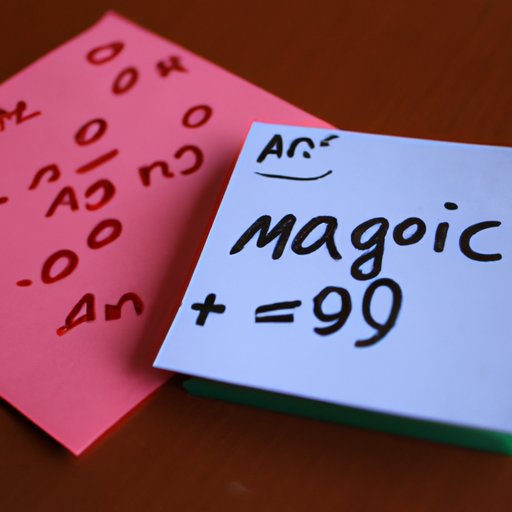
Introduction
As a beginner in chemistry, you may find yourself struggling with how to convert moles to grams. However, mastering this skill is essential to understanding chemical reactions and working in a lab setting. In this article, we’ll provide a beginner’s guide to converting moles to grams, exploring the relationship between these units, how to convert them, common mistakes to avoid, and practical applications for lab work.
Understanding the Relationship Between Moles and Grams
Before we get into the steps for converting moles to grams, it’s essential to understand the relationship between these units. A mole is a unit of measurement used in chemistry to express how much of a substance is present. One mole of a substance contains Avogadro’s number of particles, which is about 6.022 x 10^23.
Grams, on the other hand, are a measure of mass. Molar mass is the mass of one mole of a substance, expressed in grams per mole. The molar mass of a substance can be calculated by adding up the atomic masses of the elements in the chemical formula of the substance.
Converting Chemistry Units for Beginners: Moles to Grams
Converting moles to grams is a straightforward process, but it requires understanding the formula that links these two units:
grams = moles x molar mass
To convert moles to grams, you need to know the number of moles of the substance and its molar mass. Here’s a step-by-step guide to help you convert moles to grams:
Step 1: Write down the number of moles of the substance you want to convert.
Step 2: Find the molar mass of the substance. You can find this information on a periodic table or from a reference book.
Step 3: Multiply the number of moles by the molar mass to get the mass in grams.
Step 4: Round your answer to the nearest hundredths place (two decimal places) if necessary.
Let’s try an example. If you have 2 moles of methane gas (CH4), you can convert it to grams by following these steps:
Step 1: Write down 2 moles of CH4
Step 2: Find the molar mass of CH4 by adding up the atomic masses of each element in the formula:
molar mass of C = 12.01 g/mol
molar mass of H = 1.01 g/mol
Total molar mass = 16.05 g/mol
Step 3: Multiply 2 moles by the molar mass of CH4 (16.05 g/mol):
2 mol x 16.05 g/mol = 32.1 g
Step 4: Round the answer to two decimal places: 32.1 g
So, the answer is 32.10 grams of methane gas.
Mastering Mole Conversions: Tips and Tricks for Gram Calculations
While converting moles to grams may seem simple enough, there are some common mistakes you should avoid to ensure accurate calculations:
Mistake: Forgetting to write down the units.
Solution: Always make sure to include the units for each measurement. This will help you keep track of the units and make sure you’re converting from moles to grams.
Mistake: Not using the correct molar mass.
Solution: Make sure to use the molar mass of the substance you’re working with. This can be found using a periodic table or reference book.
Mistake: Rounding too early.
Solution: Avoid rounding until the final step of your calculation. Rounding too early can lead to inaccurate results.
To make your calculations more accurate, here are some tips:
Tip: Double-check your calculations.
Tip: Use a calculator with higher precision for more accurate results.
Tip: Understand the concepts behind the formula to avoid common mistakes.
Why Moles Matter: The Importance of Converting to Grams
Moles are a critical concept in chemistry because they help chemists understand the relationship between mass, atoms, and molecules. Converting moles to grams is important because it allows you to measure the amount of a substance in grams, which is more useful in lab settings.
Converting moles to grams is also necessary when working with chemical equations. When balancing chemical equations, you need to know the amount of each substance in grams to ensure the equation is balanced correctly.

Simplify Complex Chemistry Equations: Moles to Grams Made Easy
Mole to gram conversions can simplify complex chemistry equations by allowing you to work with mass instead of molecular quantities. Here’s an example:
Let’s say you want to calculate how many grams of water are produced from the reaction of 4 moles of hydrogen gas and 2 moles of oxygen gas:
2H2 + O2 → 2H2O
We know from the equation that two moles of hydrogen gas react with one mole of oxygen gas to produce two moles of water. To calculate the mass of water produced, we need to convert the number of moles to grams using the molar mass of water:
Step 1: Find the molar mass of water (H2O).
molar mass of H2O = 18.02 g/mol
Step 2: Use the equation to find the number of moles of water produced:
4 moles of H2 x (2 moles of H2O/2 moles of H2) = 4 moles of H2O
2 moles of O2 x (2 moles of H2O/1 mole of O2) = 4 moles of H2O
Step 3: Multiply the number of moles of water produced by the molar mass of water:
4 moles H2O x 18.02 g/mol = 72.08 g of water
So, 72.08 grams of water will be produced.
Practical Applications of Mole to Gram Conversions in Lab Settings
Converting moles to grams is useful in lab settings. Here are some examples of common lab procedures that require mole to gram conversions:
Titration: A laboratory technique used to determine the concentration of a solution. Converting moles to grams is necessary to calculate the mass of the substance being titrated.
Limiting reagents: A concept used in chemical equations that occurs when one substance is completely consumed during a reaction. To calculate the amount of product formed, moles need to be converted to grams.
Stoichiometry: The calculation of reactants and products in chemical equations. Converting moles to grams is crucial in determining the mass of each substance in the equation.
Conclusion
As you can see, knowing how to convert moles to grams is essential in understanding chemical reactions and working in a lab setting. By following the steps and tips provided in this article, you can master this fundamental skill in chemistry and confidently perform mole to gram conversions. Don’t hesitate to practice and reach out for help when needed.




